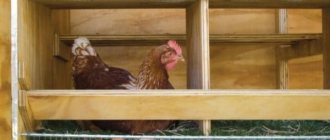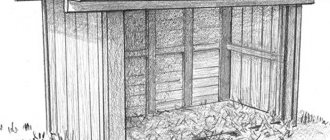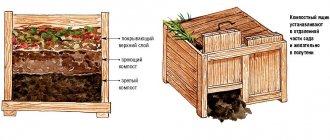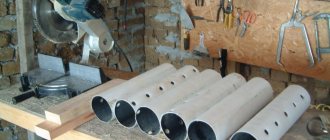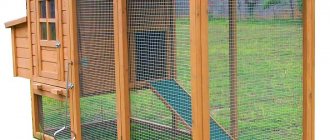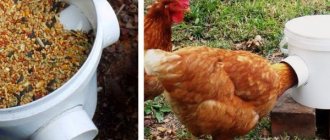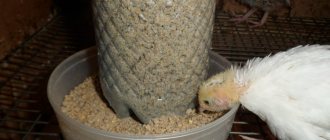An example of a fairly profitable modern farming business is the breeding of meat chicken breeds. Many poultry farmers choose broilers. This breed of chicken can gain a lot of weight if fed well. However, in addition to intensive nutrition, it is important to maintain the correct conditions for keeping poultry, taking into account some of the specifics of their rearing, fattening and stocking density. To do this, you need to understand in detail how to build a chicken coop for broilers.
Chicken coop for broilers
Distinctive features of a broiler chicken coop
First, you need to understand what distinguishes a broiler chicken coop from buildings for ordinary laying hens. It is important to understand that, first of all, the distinctive features are based on the different process of keeping laying hens and broilers. Laying hens are more restless birds than broilers, and the latter are more voracious. They also do not need to be allowed to go for walks. In addition, ordinary chickens are bred mainly for their eggs and kept for a long time; broilers are slaughtered within 2-3 months, so they do not need places for nests, which is the first and one of the main distinguishing features of such chicken coops.
Broiler content
Specific features of broiler chicken coops
- do not require nesting sites;
- minimum space requirements;
- warm structure;
- ventilation of the room and absence of drafts;
- lighting of natural and artificial types;
- comfortable floors;
- places for cells.
Advice! Feeders in broiler coops and drinking bowls should be placed in different corners of the building.
Video - Chicken coop for broilers
Additional Tips
- To prevent snow from accumulating on the roof of the poultry house, and to quickly warm it up even with scanty sun, it must be gabled and pointed.
- To ensure optimal natural light in the coop, windows should occupy at least 10% of the total wall area.
- The material used to strengthen the walls must be highly moisture resistant, maintain a warm microclimate inside the shed well, and be impenetrable to rats and other pests.
- To successfully raise broilers throughout the year, it is advisable to equip a separate vestibule in the chicken coop to limit the exposure of the flock to cold drafts.
- In order for meat-producing birds to move freely around the pen, the territory should be correctly calculated, but the space should not be exceeded so that the birds do not lose a lot of energy and actively gain weight.
- The food should be as high-calorie and balanced as possible, and the diet should be regular. In the case of raising poultry for abundant meat production, the feeders should not be empty at all. Food must be given fresh, and any leftovers must be disposed of. Water should be changed frequently, and drinking bowls should be treated with boiling water and potassium permanganate.
Methods of breeding broilers in chicken coops
There are two ways to keep broiler chickens in chicken coops:
- cellular;
- floor
The choice of method depends on the number of future poultry. Due to low costs, floor housing is preferable for large numbers of birds in private farming. In large-scale industrial poultry farming, cage breeding is now increasingly gaining popularity.
Benefits of Cell Breeding
Keeping broilers in cages significantly saves space in the room. Consequently, the cost of electricity used to heat the chicken coop, its lighting, and ventilation is reduced. Due to limited contact of birds with each other (neighborly contact), the risk of infectious diseases is reduced. Rational consumption of feed leads to savings due to the fact that the bird does not scatter it on the litter. Restriction of movement leads to accelerated growth of the bird's weight.
Cage housing of broilers
On a note! Keeping them in a cage speeds up fattening by 3-5 days.
Advantages of outdoor breeding
The main advantage is that there is no need to buy cages and equipment for them. This method also allows you not to remove poultry droppings on a daily basis, but to do it less often due to floor bedding. There are no problems with the paws, which develop when kept in cages. The quality of chicken meat is higher.
Floor keeping of broilers
Broiler chickens are placed in a special box - a brooder, where they feed and receive the necessary heating and lighting.
DIY chicken brooder
A newly born chick needs a warm, bright atmosphere and regular feeding. In the natural environment, this is facilitated by chicken, and when kept at home, it is recommended to use a special room for birds - a brooder. It is very easy to build it yourself: at home or on a livestock farm. In this article we will take a closer look at how to make a brooder for chickens with your own hands.
Ventilation in the poultry house
Video: Tetracycline for broiler chickens (dosage with water)
Without access to clean air in the small space of the chicken coop, the health of the flock is jeopardized. For poultry houses, 3 methods of ventilation are used:
- natural;
- supply and exhaust;
- mechanical.
The first is the most budget-friendly, suitable for keeping a small number of chickens.
It is based on normal ventilation. The second method is much more effective and easy to implement. Large farms (more than 100 chickens) are equipped with a third type of ventilation.
How to choose a suitable place?
The choice of area for construction should be based on the following key points:
- The chicken coop should be located away from noisy roads.
- It is better to erect the structure on a dry, elevated place.
- The shadow of trees and nearby buildings should not fall on the windows of the chicken coop and its southern part.
- The building should be tilted slightly in a southeast direction.
The right place for a chicken coop
Let us explain the reasons for these recommendations. Many meat breeds are sensitive to loud noises and nearby traffic will make broilers nervous, which will reduce weight gain. An elevated place will help keep the room dry. In low-lying areas, water from rain and melting snow can accumulate, which will increase the dampness inside the chicken coop and contribute to the formation of mold, the growth of bacteria, and increased illness in chickens. The best option is sandy soil. If your site is swampy or clayey, then before construction it should be dried and sprinkled with a layer of sand. The shade from the trees will block the light and reduce the temperature balance inside the coop. Tilting the building to the southeast will make it more exposed to sunlight.
Summer chicken coop
Advice! If there are strong winds on your site, then it is worth building a fence or planting a hedge of weaving plants on the side of the wind so that there are no drafts in the chicken coop.
What should the building be like?
A do-it-yourself chicken coop for broilers has many advantages over purchased housing for birds. Firstly, this can significantly reduce construction costs. Secondly, the room will be adapted for a certain number of birds, and thirdly, self-built housing for chickens is much stronger than store-bought counterparts.
Standard housing requirements:
- small size;
- high quality illumination;
- optimal sizes for convenient placement of cells;
- reliable protection against the penetration of rodents and predators.
Containers for food and drink should be located in different parts of the chicken coop (in no case in one). To ensure appropriate temperature conditions in winter, it is necessary to install electric lamps. One of the important nuances in building a chicken coop with your own hands is the location. It is advisable to install the room on dry, sandy soil. If the soil is wet, it must be covered with sand after drying.
When keeping chickens in winter, the chicken coop must have a vestibule. It should be insulated from the outside with metal sheets, and a layer of foam plastic should be laid between them and the wall. The inside of the vestibule is lined with sheets of plywood or fiberboard. The roof is insulated with mineral wool. The windows should also be well treated: all cracks should be sealed, it is advisable to insulate the slopes if the openings are large.
Typical design mistakes and do-it-yourself installation recommendations
During installation in practice, much fewer problems arise than at the design stage. An error in the design can make the process significantly more complicated. However, if the project is designed correctly, the correct drawings are selected and good materials are purchased, then it can be implemented in a relatively short time with little money.
Do-it-yourself installation has a number of advantages:
- Only you are responsible for the quality of installation work, doing everything conscientiously and firmly.
- You save on installation costs and gain experience that will help you in the future operation of the structure.
- During the installation process, you can refine the design data based on your new ideas.
Chicken coop frame for broilers
At the design stage of the chicken coop, it is important not to make those gross mistakes that may require reworking the entire structure of the building or create additional installation problems. Let's look at the most important design mistakes in broiler chicken coops.
Lack of rodent protection
When designing, you must take into account that the chicken coop must be raised at a distance from the ground. The insulation layer must not be allowed to come into contact with the ground. This can lead to a threat from rats, which are able to chew through the tree and climb inside. It is recommended to fill the lower zone between the insulation and the soil with broken glass. Mice simply will not be able to dig close. Also, direct contact with the ground can pose a risk of flooding.
Preventive measures against the appearance of rats
How to deal with rats in a chicken coop?
The appearance of rats near the chicken coop becomes a big problem. Gnawed holes and stolen eggs are not the biggest troubles from their neighborhood. Many farmers are interested in the question: how to deal with rats in a chicken coop? In this article you will find the most effective ways to get rid of rodents.
Prices for rodent protection
Rat protection
Using unsuitable materials
Experts do not recommend using isoplats, plasterboard sheets, PVC plastic, or chipboard for cladding. They have the ability to accumulate moisture, which makes them easily destructible materials during heavy rainfall. At the same time, they can release toxic substances that are dangerous to birds. Mold can also form, making chickens sick.
What you should pay attention to when installing a broiler chicken coop:
- The chicken coop must be safe - protected from rain, hail, snow, and predators.
- Have a good foundation.
- Be fireproof.
- Be built from environmentally friendly materials.
- Well insulated.
- Have a ventilation or ventilation system.
- Do not have drafts or cracks.
- Heat with combi or wood stoves.
- Be well lit.
- Sit on a hill.
Chicken coop with open aviary for broilers
On a note! You can often hear that a broiler can grow in 1.5 months. up to 1.5 kg. This is not entirely true if you intend to raise birds at home. This growth can be achieved in factory-farmed poultry farming using antibiotics and growth hormones. In fact, broiler chicken for 1.5 months. reaches approximately 800 gr.
What should be inside
A lighting and heating system is installed from the inside to keep the chick compartment warm. If winter poultry breeding is planned, then care must be taken to have a heating system. The walls are treated with lime and the wooden surfaces are painted. A net is placed over the windows.
To minimize the access of blood-sucking insects (who are carriers of diseases), it is recommended to cover ventilation ducts and vents with a mosquito net.
When keeping cages, the installation of shelving is carried out first, and then the cages. Bird feeders can be located both inside and outside. A water supply system is being installed to supply water to the automatic drinkers.
Automatic drinkers for chickens
Floor maintenance requires the presence of perches, drinking bowls, feeders and a dry bath for the ash-sand mixture.
How to arrange the cells
Cage keeping is impossible without racks where the cages will be installed; you can buy them in a specialized store or make them yourself. The cages are installed on racks made of metal or wood; as a rule, they have several tiers. The height of the cage must be at least 50 cm.
Placement of feeders and drinkers
It is best to place food containers on the outside using special fastenings. Feeders can be made from various materials or purchased separately. The mesh around the feeders should have a cell section of 14x14 cm so that broilers can have comfortable access to feed.
An automated watering system should be installed from inside the cages. In some cases, vacuum drinkers may be preferred, but such containers must be installed in each cage.
If nipple drinkers are selected, then there is one device per 10 birds.
Bedding materials
When keeping the chicken coop on the ground, it is necessary to fill it with various materials that will act as bedding. Eg:
- straw;
- sawdust;
- peat;
- husk.
Straw for bedding
The main requirements here are good moisture retention and a low risk of injury to the bird. The litter will help the chickens realize their natural reflexes (loosening and digging the soil). The thickness of the materials is laid depending on the season; in summer you can pour less, in winter - more.
We invite you to join our Zen channel and group on VKontakte or Odnoklassniki, where new articles are published, as well as news for gardeners and livestock breeders.
Similar articles:
- Liera among chickens for seasonal poultry farming. Which breed should I choose?
- What should a new farmer know about feeding chickens?
- Frostbite in chickens: what do you need to know about the signs and treatment?
Necessary materials and tools for construction
To build a wooden insulated chicken coop you need to have the following approximate list of materials:
- wooden beam 100x50 and 100x100 mm;
- insulation;
- roofing felt;
- cement;
- brick;
- nails;
- pebbles;
- crushed stone;
- board 20 mm;
- construction resin;
- metallic profile;
- mineral wool;
- staples;
- self-tapping screws;
- roulette;
- building level;
- saw;
- screwdriver;
- drill;
- hammer.
Prices for timber
timber
Wood, plywood and brick are usually used to construct wall coverings. The foundation requires sand, slag, cement and wood formwork. Roofing material and slate are used for the roof. Wood slats are used for partitions and rafters.
Video - DIY chicken coop
Step-by-step instructions
Before starting work, it is recommended to check the availability of all tools, materials and dimensions in the drawing. During the preparatory work, the area must be cleared for the subsequent construction of the chicken coop. This place is marked with pegs according to the construction plan.
Foundation
- Holes are dug where the pipes will be installed, their subsequent installation is carried out, and gravel and sand cushions are made between the pipes at the bottom of the pit.
- Such pillows should have a thickness of 0.2 m. A columnar foundation means the presence of pipes into which fastening fittings are inserted under the racks of the room. The inside of the pipes is filled with concrete mortar.
- After the concrete has hardened, a strapping of floor bars is attached to the reinforcement.
- The pipes are grounded to a depth of 1 m, maintaining a distance between them of at least 75 cm. The pipes should rise above the sand and gravel bed to a height of 20 cm, and the fittings for fastening the racks should be at least 25 cm.
- The timber frame is attached to the reinforcement posts through drilled holes - grooves.
- Waterproofing should be laid on top of concrete pillars, for example, from a few words of roofing material.
- Self-tapping screws are used to fasten the timber.
Chicken coop foundation
Construction of walls and their insulation
- On the base frame, supports for the walls are made and a subfloor is installed.
- Doors to the room and window frames are placed between the support beams. If there is a need to make a door through which the chickens will go for walks in the enclosure, then it must be installed at this stage.
- The ventilation system is being installed.
- The walls are built from slabs, most often compressed shavings. This material is not afraid of moisture, holds heat well, and is resistant to pests. Self-tapping screws are used to fasten the plates.
- Polyurethane foam is used to fill the resulting gaps.
- The outer surface of the walls is treated with bitumen mastic. This material will further protect the surface from moisture.
- The floor is being installed from inside the room. First, wooden boards are laid on the joists, then there is insulation and, as the third layer, the finished floor.
- Insulating materials are laid on the walls inside the room, slats are used to secure it, and only then is sheathing with another layer of tiles.
Building walls
Roof
Hardwood is suitable for this part of the building. You can build a roof with or without a small attic space. The presence of such space has a beneficial effect on air exchange processes, in addition, the service life of wooden elements increases.
The roof with the attic is erected using a flooring, on which boards or slabs are placed, then the ceiling beams are installed and the covering is installed.
If the roof is without an attic, then:
- the main frame is strengthened on supports in the form of pillars;
- then it is covered with insulating materials and boards in the style of walls.
Roof installation
The finished roof is covered with materials such as slate or metal tiles. When installing the roof, it is important not to forget about installing ventilation pipes; they should be 2 m in height and at least 20 cm in diameter.
Chicken coop drawings for broilers
We invite you to familiarize yourself with the most interesting drawings of chicken coops for breeding broiler chickens.
The first option involves a large spacious enclosure, a place for perches and a vestibule.
Drawing No. 1 – Chicken coop with aviary
In the second picture you can see the calculation drawing for a broiler cage with a feeder.
Drawing No. 2 – Broiler cage
The following drawing is made in projection and also assumes a large closed enclosure.
Drawing No. 3 – With a large closed enclosure
If you plan to seriously engage in broiler poultry farming, then the version of the drawing for two tens of thousands of birds will be interesting.
Drawing No. 4 – Poultry house for 22,000 birds
For many farmers, a drawing for making a multi-tiered version of cages will be extremely useful.
Drawing No. 5 – Multi-tiered cages for broilers
In the last picture you can see a detailed detailed drawing of a broiler chicken coop.
Drawing No. 6 - Detailed design of a chicken coop
Features of a Broiler Shed
- A simple house for broiler chickens should have dimensions based on the diagram: fifty chicks or a dozen adult birds per square meter of cage.
- A country chicken coop should contain several rows of cages stacked on top of each other. The top cage is installed at 1.5 meters maximum permissible height. It is the structure that has these parameters that will be easiest for you to care for.
- Even a summer chicken coop for broilers should be equipped with additional lighting devices.
- Electric lamps will also help provide such an important factor as a comfortable room temperature. If necessary, they will serve as a good heater for the chicks.
- It is advisable to keep the smallest chickens separately from older residents. It would not hurt to install lamps in their cages that would provide both light and heat at the same time.
How to make a chicken coop for broilers with your own hands: tips for beginners
- It is better to make the flooring in the form of concrete or clay concrete screed. Before pouring it, you should sprinkle the perimeter of the future building with a mixture of broken glass, sawdust or shavings.
- Water barrier film helps to insulate the roof and keep the chicken coop free from moisture.
- In northern latitudes, the thickness of the main walls of the chicken coop should be from 20 cm.
- Don't forget to make windows in the chicken coop. Good ventilation will help keep your bird healthy. You should also take into account that the size of the windows should be at least 1/12 of the base area of the chicken coop.
- Take the time to put mosquito nets on the windows and vents. Midges and mosquitoes are very attracted to the smells of chicken droppings. For chickens, they pose a mortal danger because they can get into the nostrils, which can cause the bird to suffocate.
- The bird develops better under yellow lighting, which is characteristic of sunlight in nature. Regular incandescent light bulbs meet this requirement.
- Make ventilation holes in the walls (20 cm from the floor) and ceiling. This will significantly reduce unpleasant odors indoors and increase air circulation. In winter, they are closed to maintain a constant temperature inside.
An example of organizing a ventilation system in a chicken coop
Conditions for raising broilers
Before you choose where and how to build a chicken coop for broilers, you will need to delve into and understand the technology of modern broiler poultry farming. The methods of feeding and keeping poultry, and the chicken coops themselves for broiler chickens, are somewhat different from the traditional village or country farming scheme:
- The vast majority of broilers for sale are raised in cages. Up to 10 adult broilers “live” in each cage;
- Chicken coops for keeping broiler chickens are arranged in the form of nets placed on wooden or metal racks in several tiers. The nets are equipped with external feeders and drip drinkers, which allows rational use of feed and water;
- The nature of the room chosen for the chicken coop has practically no effect on the maintenance of the broiler; it is enough if the inside is from +12°C to +18°C for adult birds and a compartment with + 35°C for chickens.
You can make a chicken coop for broilers in a utility room or metal garage, as in the video:
or in a wooden shed, in principle this does not matter, the main thing is to maintain the necessary parameters of humidity, temperature and ensure good ventilation.
Important! A large concentration of poultry in a confined space requires special attention to the health of the broiler; it will be necessary to carry out regular preventive measures to prevent infectious diseases. Otherwise, an outbreak of influenza or intestinal infection could destroy the entire brood of broilers in contact with each other in the chicken coop
Otherwise, an outbreak of influenza or intestinal infection could destroy the entire brood of broilers in contact with each other in the chicken coop.
Therefore, when choosing a material and method for making a chicken coop, it is necessary to choose the right material and device so that disinfection and sanitation do not affect the design of the cages and equipment in the chicken coop, as in the video:
Instructions for building a chicken coop for broilers
Drafting
The first step at this stage is to determine the size of the planned structure. It is necessary to take into account the number of birds that will live in the chicken coop, and the characteristics of the building materials used during the construction process.
If the area for construction is limited, the requirements for the bird landing area should be taken into account. This breed of chickens does not need a lot of space to roam.
| Breeding method | Number of chickens per 1 sq.m. | Number of adults per 1 sq.m. |
| Floor | 8 | 4 |
| Cellular | 25 | 12-18 |
When planning a site for construction, you can use these recommendations for planting birds. In addition, a multi-tiered cage system can be used to save space. In this case, the upper tier should not be raised from the floor by more than 1.5 m.
Broilers in the summer section of the chicken coop for walking
Pouring the foundation and laying the floor
Before pouring, we dig a pit to a depth of 40 cm. Next, we lay supporting horizontal beams made of 100x100 wooden beams at a distance from each other in the formwork of 20 cm and fill them with sand-cement mixture. If you plan to use it exclusively in the spring-autumn period, then an option with a depth of 20 cm is allowed.
Prices for cement and basic mixtures
Cement and base mixtures
Pouring the foundation
Our foundation should rest for 3 days. After they have passed, we check how dry it is. It may take some more time. Once you are sure that the foundation is dry, you can begin installing the floor.
The most suitable flooring material is wood, since it can retain heat for a long time and protects against sudden temperature changes. For waterproofing purposes, before installing a wooden floor, we lay sheets of roofing felt around the entire perimeter. We place the first crown, aligning the ends of the beams. Then every half meter we place logs on the edge. The space between them must be filled with insulation. Then we install the floorboards using the tongue-and-groove method.
You can insulate the floor using a bedding of hay mixed with peat or sawdust. The thickness of such litter should be up to 40 cm. It is important to remember that this type of litter contributes to the accumulation of ammonia vapors that are released from the droppings. These fumes are poisonous and the chicken coop must have a ventilation system.
Construction of the walls of the summer version of the chicken coop
Advice! A slightly sloping floor will help with cleaning the coop as water will drain into one corner along with dirt.
Video - Arrangement of a chicken coop for broilers
Construction of walls
The next step is building the walls. An important role of walls is to retain heat. It is recommended to make them from a frame made of beams. We install the walls at a height according to your drawing, leaving openings for windows and ventilation. Upon completion of fixing the beams, it is necessary to cover them on both sides with boards or plywood.
Advice! For normal brightness of natural light, the windows in the chicken coop should be equal in area to a tenth of the entire floor area.
The walls can be not only wooden, but also made of brick or concrete. In this case, their insulation is even more important.
Construction of the walls and roof frame of the chicken coop
Insulating walls in a chicken coop
Before starting work on upholstering the wall frame with plywood or boards, you should understand which side the insulation layer will be attached to. It is better if it is on the outside, as this will protect the walls of the chicken coop from freezing, and they themselves will not become a cold accumulator. Insulation with a thickness of at least 5 cm is laid between the frame beams.
How to insulate a chicken coop
In order to eat fresh eggs and poultry all year round, it is necessary to properly insulate the house for laying hens, providing them with a comfortable winter. In our article you will find step-by-step instructions for insulating walls, floors and roofs. And also everything about installing a heating system in a chicken coop.
Thermal insulation material used for wall insulation:
- sawdust and shavings;
- straw;
- moss;
- mineral wool;
- Styrofoam;
- polymer filler;
- foam rubber
Prices for mineral wool
Rockwool mineral wool
The most commonly used is mineral wool. The choice is determined by its high elasticity, which allows you to seal all the cracks. To avoid moisture ingress, it is covered with a vapor barrier and windproof film, secured with a construction stapler and slats are stuffed on top. For external decorative upholstery, you can use boards or siding.
Insulating the chicken coop with mineral wool from the outside
Cheap and effective materials are moss and pine sawdust. The first one perfectly absorbs moisture and fights unpleasant odors. In the second case, the disinfectant and insecticidal properties are enhanced. Of the two options, we recommend choosing the latter. Sawdust is close to mineral wool in its thermal insulation properties. To slow down the decay process and reduce the risk of fire, they are mixed with copper sulfate, slaked lime and boric acid. The thermal insulation mixture is laid between two layers of boards, which are installed at the stage of wall construction. A factory analogue of this method of insulation can be a wood block.
Roof structure
When our walls are erected, we begin to build the roof. We make the roof from hard wood and lay roofing material around the perimeter. Do not forget to treat wooden structures so that insects cannot settle in them and increase their moisture resistance.
First we lay the flooring, then we attach the ceiling beams of the gable roof at an angle. The design of the gable roof makes it possible to avoid the accumulation of snow and rain, which additionally protects against high humidity in the room. The flooring must be insulated. There's nothing complicated about it. Expanded clay or ordinary coal slag can serve as insulation. We attach roofing felt sheets to the beams, then cover everything with slate or similar roofing material.
Roof construction
An important element in the roof of a chicken coop is the ventilation pipe. Its diameter is usually 20 cm. The length of the pipe must be at least 2 meters. We make a hole in the roof of the required diameter into which the pipe is inserted. In the chicken coop it is recommended that she protrude 20 cm.
On a note! The optimal air humidity should be 60-70%, and the temperature 12°C -16°C.
Interior work
The chicken coop construction process is almost complete. The final stage is to carry out internal work, such as installing electricity, installing a heating system, if required, installing broiler cages, feeders, drinkers, and laying out bedding.
A Buleryan stove, electric heating, or even pyrolysis boiler equipment can be used for heating. It is recommended to plaster the walls and cover them with lime. In the future, whitewashing should be done when replacing a batch of birds. Rodents and dangerous predators often sneak through cracks and uneven areas in floors. Check and be sure to seal with cement-sand mortar anything that poses such a threat.
Chicken feeders
Feeders are available in two types: hanging and floor-mounted. If in the first case only a few chickens can feed from one feeder, then the second type allows many birds to feed at the same time.
On a note! For normal intensity of artificial lighting, it is better to hang lamps at a height of 1.5-2 m from the floor, based on the calculation of 3-5 W per 1 sq.m of floor area.
Ash baths for chickens
Inside the chicken coop should be equipped with special baths with sand (or fine clay) and ash. Chickens can swim in them. This is necessary to maintain their feathers in normal condition and protect them from ticks and other insects. The baths can be made from ordinary plywood or any container with a wall height of 15-20 cm can be used. You can add a little garden lime to the mixture.
Before starting chickens, the floors can be sprinkled with fluff lime. 0.5 kg of lime is enough for 1 sq.m. The bedding is placed on top with a thickness of about 5 cm.
Calculations and diagrams
An important point on how to make a chicken coop for broilers with your own hands is drawing up a construction diagram. Before drawing up a project, you should decide on the number of chickens. Unlike laying hens, broilers are kept in small rooms. Planting density per 1 sq. m is 50 chickens or 5 adult chickens. Based on these parameters, you can make accurate calculations and draw up drawings.
It is recommended to install cages in 2 tiers to save space. The bottom row should be located no higher than 1.5 m from the flooring. The chicken coop can be of any shape, depending on personal preference. It is possible to build a chicken coop for broiler chickens from wood or use brick for construction, then the structure will be more durable and frost-resistant.
Before building a chicken coop for farm broilers, it is necessary to prepare all materials for construction in advance. The walls, roof and floor of the chicken coop must be insulated. Also at the building planning stage, it is necessary to outline the location of the ventilation system and decide on its type. The ventilation system can be of 3 types:
- natural;
- supply and exhaust;
- automatic.
The room will be small, so a natural ventilation system will suffice. This system involves ventilation by opening the door and dormer window.
It is very important to position it correctly so that the chickens do not get caught in a draft, so you should make a note right away in the planogram. The location of the window will depend on the location of the cells
It can be located on the roof or above the front door.
Useful tips for arranging a chicken coop
How to make your own feeder for broiler chickens
We will need a large diameter polyvinyl chloride pipe. Prepare a tee, plugs and your tool with which you will cut the pipe. First, we cut it into pieces: 70, 20, 10 cm. We put a plug on a 20-centimeter piece, which will become the lower end of our feeder.
Chicken feeder
We put the tee on the top with its side. We insert the longest pipe and close it with a plug. We insert a 10-centimeter section into the remaining part of the tee. We attach the made device to the cage with the bird and pour food into it.
How to make drinking bowls for broiler chickens yourself
It is not at all necessary to buy store-bought drinking bowls. Let's try to make a nipple on our own in a few minutes. We will need: a plug, a plastic pipe - 1 m, a nipple.
First of all, we will drill small holes in the pipe at intervals of up to 25 cm. As a result, you should get at least 4 drinkers. We make a thread in the pipe by screwing a thread-cutting tool into it. We connect the two parts of the pipe. We place a prepared plug on one end to prevent water from draining. On the other we place a knee at an angle of 90°. The reservoir will be a small piece of pipe, which we will connect to the unoccupied end of the elbow.
Broiler drinker
We wrap the nipple well with a sealant and screw it in to the edge. This completes the creation of the drinking bowl. All that remains is to test the structure for possible water leaks and seal them.
Feeders and drinkers
It is also possible to build feeders and drinking bowls with your own hands from scrap materials. The designs are best made of the automatic type. Broilers need a sufficient amount of feed, so you need to constantly ensure that the feeders are filled. This is not very convenient, especially if you have a large farm and a lot of things to do. Chickens also have a habit of getting into the feeders with their paws and scattering the feed, which makes it unusable and quite costly to your pocket, so a feeding hopper system is an ideal option.
Depending on the size, such a feeder can hold an amount of food that is enough for at least knocking. It is beneficial to install nipple drinking systems. This allows the chickens to have free access to water and maintain its purity. It is very easy to construct such a system with your own hands. From a large plastic tank, water is supplied to flexible hoses, and from them flows into nipples, and then into drip trays. In winter, you can put a regular boiler in the water tank to heat the water.
Optimal sizes
If you approach the issue of determining the size of a chicken coop scrupulously, then for each breed of bird there is a certain standard of “living space”. But in a country house or in a private house they rarely keep a purebred bird. Therefore, they start from the average.
There are some general guidelines to follow when creating a chicken coop project.
Estimating the area and dimensions of the building
When building a chicken coop, they usually proceed from the planned number of birds. It is believed that 2-4 chickens can live on 1 square meter of area. If we are talking about broilers, you can take 3-4 pieces per square meter. They are inactive and this area is enough for them. If we talk about laying hens or meat and egg breeds, it is believed that the optimal number is 2-3 birds per square area. So, a chicken coop for 10 broiler chickens can have an area of -2-3 square meters, a poultry house for 10 chickens - when keeping laying hens or meat and egg breeds - requires 4-5 square meters. If you decide to build a chicken coop for 20 chickens, the area for broilers will be 5-7 squares, for eggs and meat - 8-10 squares.
A beautiful chicken coop for 10-20 chickens does not need to be hidden in the backyard
But knowing the area of a chicken coop for 20 chickens or 10 is not everything. We still need to decide on the sizes. Most often they try to make a rectangular building: 3 * 1.5 m; 4*, etc. In this case, you can clean the poultry house without going inside - a rake, scraper, broom will reach even the far corners. Square ones are not so convenient in this regard, although a small chicken coop for 10-20 chickens will still not be large. So a square is fine.
How tall should the chicken coop be?
When building a chicken coop, you still need to decide on the height of the building. For birds, a height of about 140-150 cm is sufficient. But you must remember that you will have to clean the house, collect eggs, and change bedding. So when choosing the height of the poultry house, they proceed from their own convenience. For this reason, the roof is made higher than head level - so that you can walk upright.
The height depends on whether you will go inside for service or not.
No overlap
There are two options when installing a roof. First: if the poultry house is without a ceiling (ceiling), you can remove the walls by about 140-150 cm, make the roof gable and raise the ridge by 180-200 cm (or a little higher, as is convenient for you). In this case, you can move around the center of the room without problems, but we still rarely go to the edges. There is usually a perch and nests there, and there may be bedding
You will have to work carefully in this area, protecting your head.
There may also be no overlap inside
The benefit of this option is that with this arrangement we save on wall material. The downside is that more is spent on insulating the roof: it must be insulated over the entire area, which is significantly more than what is required when insulating the ceiling. But, in general, this option turns out to be less expensive, but also less convenient (you have to take care of your head).
With attic
The second option for how to build a chicken coop for 10-20 chickens is to make a mini-copy of a regular house. In this case, the walls are driven to the height required for free movement inside. This is a person’s height, plus 10-20 cm. But keep in mind that part of the height will go to the ceiling, there will also be a floor and bedding on it. Each requires about 15 cm of height. So, if the owner of the chicken coop is 180 cm tall, you will have to make walls with a minimum height of 220-230 cm.
With overlapping you will have to insulate less
As you can see, this option will require more materials for the walls, but only the ceiling (ceiling) can be insulated, and the attic can be left cold. The attic can also be used to store straw, bedding, etc. But don’t forget about rodents, who love such storage facilities and can become a problem.
On poles
Another option: make a chicken coop for 10 chickens on poles. In this case, 4 beams are dug into the ground at the corners of the building, the floor covering is made at a height of 50-80 cm from the ground level. The roof is made at a height of 180-200 cm. In general, this is a convenient option for a mini-chicken coop for a summer residence. This is more of a summer option, but can be insulated. In order for the bird to be able to get in and out, an inclined ladder is made from boards with thin perches nailed about 10 cm apart to make it easier for the bird to move.
Why not a mini-chicken coop for 5-6 chickens?
In general, you choose the height and general construction plan at your own discretion.


